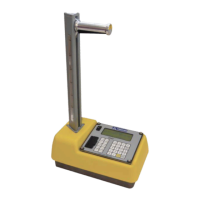
Do you have a question about the Troxler 3440-L and is the answer not in the manual?
| Model | 3440-L |
|---|---|
| Category | Measuring Instruments |
| Type | Nuclear Density Gauge |
| Display | LCD |
| Measures | Density and moisture |
| Measurement Principle | Nuclear |
| Measurement Parameters | Density, Moisture |
| Source Type | Cesium-137 and Americium-241 |
| Detector Type | Geiger-Mueller tube |
| Power Supply | Rechargeable batteries |
| Operating Temperature Range | -10°C to 50°C |
| Standards Compliance | ASTM D6938, ASTM D2922, ASTM D3017, AASHTO T310, AASHTO T238 |
Overview of the gauge's features, capabilities, and manual structure.
Details and illustrations of the gauge and its standard accessories.
Explanation of the gauge's control panel keypad layout and functions.
Procedure for powering on the gauge and its initial self-test phase.
Steps for performing a daily visual inspection of the gauge's safety features.
Configuration of essential gauge parameters like units and count time.
Options for selecting different count times to affect reading accuracy.
Selecting between Soil and Asphalt modes, including sub-mode options.
How to input and manage project numbers for data storage and recall.
Instructions for adjusting the gauge's internal clock and calendar settings.
Procedure for performing a standard count to ensure gauge accuracy and stability.
How to access and review the gauge's stored standard count history.
Steps for preparing soil and base course surfaces for accurate measurements.
Procedure for preparing asphalt surfaces to ensure proper gauge contact and readings.
Procedure for performing density and moisture measurements.
How to save measurement data using project and station numbers.
Adjusting gauge readings to compensate for material properties or environmental factors.
Procedure for enabling and setting wet density offset values.
Process for enabling and setting moisture offset values.
Method for applying offsets when measuring inside trenches or near structures.
Configuration of different count times to affect measurement accuracy.
Saving measurement data with project and station numbers for later recall.
Storing and using Proctor, Marshall, and Voidless density values for compaction calculations.
Checking current gauge settings and operational status without executing functions.
Selecting between Soil or Asphalt measurement modes.
Managing project numbers for organizing and storing measurement data.
Downloading stored project data to a printer or computer.
Removing all stored project data from the gauge's memory.
Reviewing density and moisture counts from the last measurement.
Reviewing the last recorded density and moisture readings.
Selecting between manual or automatic depth measurement modes.
Using the gauge as a four-function calculator for basic arithmetic operations.
Performing a statistical stability test to validate normal gauge operation.
Checking the gauge for long-term drift by comparing current readings to stat test averages.
Function to potentially recover accidentally erased project data from memory.
Storing numeric information under a specific station number for project data.
Initializing and enabling automatic station number incrementing for readings.
Re-calibrating gauge constants for specific materials or conditions.
Using the Nomograph method for determining thin asphalt overlay density.
Setting and achieving specific precision limits for test measurements.
Selecting display and printout units between Metric and PCF.
Configuring the data transmission speed for printers or computers.
Selecting transmission protocols (Line Feed with Carriage Return).
Methods for monitoring and displaying battery status, life, and voltage.
Calculating theoretical standard counts to compensate for radioactive source decay.
Configuring gauge prompts for specific project data collection (e.g., FHWA).
Adjusting the gauge's current time-of-day and date settings.
Entering or changing the name of the gauge owner for reports and printouts.
Changing the gauge's serial number if lost in memory.
Updating the date of the last gauge re-calibration.
Changing gauge constants for test result calculations; requires re-entry if memory is lost.
Manually setting the rod length if depth readings appear incorrect.
Removing all standard counts from the gauge memory.
Erasing critical gauge information; for service personnel only.
Function for service personnel use only.
Inputting the factory calibration standard count into the gauge.
Function for service personnel use only.
Explanation of how the gauge measures density using direct transmission and backscatter modes.
Explanation of how the gauge measures moisture content using neutron thermalization.
Fundamental components of an atom: protons, neutrons, and electrons.
Explanation of radioactivity, curies, becquerels, and half-life.
Understanding radioactive emission as a random process and Poisson distribution.
Definitions of radiation units like rad, rem, mrem, and quality factors.
Identification of radiation types produced by the gauge: alpha, beta, photons, neutrons.
Methods for limiting radiation exposure: time, distance, and shielding.
Requirements for personnel monitoring and dosimetry for radiation workers.
Table showing radiation dose equivalent rates for different parts of the gauge.
Description of how the radioactive sources are sealed and protected.
Steps to follow in case of a lost, stolen, or damaged nuclear gauge.
Requirement for a specific license issued by the US NRC or equivalent state agency.
Maintaining control of the gauge to minimize radiation exposure to operators and the public.
Requirement for wearing monitoring devices to record operator radiation exposure.
Providing security to prevent unauthorized use or removal of the gauge.
One-day training seminar for nuclear gauge operators and Radiation Safety Officers.
Procedure for leak testing the gauge annually to ensure source integrity.
Posting a 'Notice to Employees' where gauge users and others can view it.
Actions to take if the gauge is lost, stolen, or physically damaged.
Following strict methods for disposing of radioactive materials.
Documentation requirements for licensing agencies, including licenses, certificates, and reports.
Major requirements for transporting nuclear gauges in the United States per DOT regulations.
Procedures for notifying agencies in case of an incident involving radioactive material.
Requirements for training, testing, and certifying hazmat employees.
Regulations for transporting dangerous goods and radioactive materials in Canada.
Information on gauge battery condition, charging, and life indicators.
Instructions for using alkaline batteries as an alternative to rechargeable ones.
Procedures for maintaining mechanical parts including sources, sliding block, and bearings.
Guidance for electronic maintenance, emphasizing service by qualified personnel only.
Diagnosing and resolving common gauge operational issues and error messages.
Troubleshooting steps when the gauge fails to complete standard counts.
Diagnosing and resolving issues when the gauge does not provide density readings.
Identifying causes and solutions for erratic or unstable gauge readings.
Troubleshooting steps for issues related to the gauge powering off or failing to turn on.
Resolving issues with the depth indicator, including potential CPU board or strip malfunctions.
Diagnosing and correcting issues related to short battery life after recharging.
Steps to correct inaccurate battery life hour readings and monitor battery status.
Troubleshooting the RS-232 port for connectivity and data transfer issues.
Resolving errors when counts are correct but results are inaccurate.
Troubleshooting steps for display issues like garbage data or error messages.
Common indicators of gauge malfunctions related to internal boards and modules.
Common indicators of CPU board issues and malfunctions.
Common indicators of preamp board issues and malfunctions.
Common indicators of high voltage module issues and malfunctions.
Understanding and correcting common error messages displayed by the gauge.
Diagrams and part numbers for replacing components of the 3440-L gauge.
Procedure and required information for sending a gauge back for repair or service.
Detailed accuracy and error specifications for density, moisture, and depth measurements.
Specifications for calibration standards and operational ranges.
Details on gamma and neutron sources, shielding, and radiation profiles.
Specifications for the gauge's RAM and ROM memory capacities.
Specifications for time accuracy, power supply, battery, and data formats.
Specifications for vibration, drop tests, operating temperatures, dimensions, and weight.
Log sheets for recording standard count dates, moisture, and density values.
Data sheets for recording project, station, offset, and measurement details.
Conversion factors for common measurement units (inches, feet, pcf to metric).
Conversion factors for radiological units (rem, Ci, mCi, µCi to Sv, GBq, MBq, kBq).
Overview of using Windows HyperTerminal for data transfer from the gauge.
Step-by-step guide to configuring HyperTerminal for gauge data transfer.
Connecting the gauge to a computer using the appropriate serial cable.
Procedure for printing or uploading project data from the gauge to a computer.
How to view uploaded data files (.txt) and import them into spreadsheets.
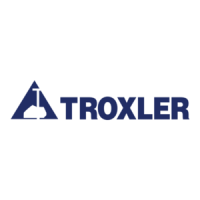

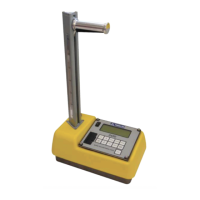


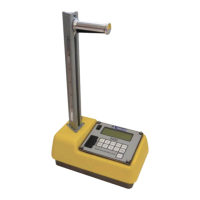
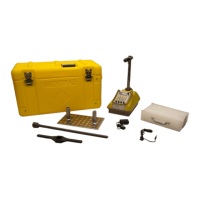
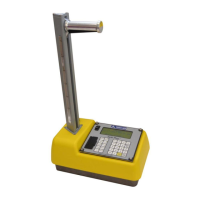


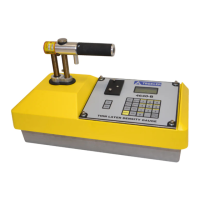

